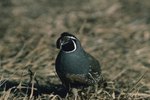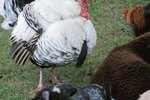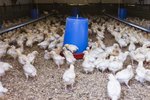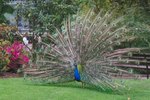
Humans domesticated chickens at least 7,500 years ago in Asia. Their prominence as a food source makes domestic chickens the most populous birds in the world with a wide range of breeds and characteristics. Despite the ubiquity of the domestic chicken, there are wild chickens as well, specifically jungle fowl and feral chickens. In the wild, these birds are foragers, eating an omnivorous diet of plant matter, insects and other small creatures.
Foraging
Domestic chickens are believed to have originated from the wild red jungle fowl (Gallus gallus) in Southern Asia. The red jungle fowl is a forager. It vigorously scratches the forest floor searching for food amongst ground matter and soil. As an omnivore, the red jungle fowl will eat many types of food it finds on the ground, from insects and worms to seeds, berries and even small animals or reptiles.
Feral chickens, domestic chickens that have returned to the wild, use similar omnivorous foraging tactics and will eat a similar diet if available. There are also reports of feral chickens living among human populations and foraging on discarded human food.
Insects and Invertebrates

Insects are the staple of the jungle fowl’s diet. Its most preferred insects are termites and winged ants, which it can forage on at dawn and at dusk. Termites are rich in fat and protein, making them an excellent food source for jungle fowl and other birds. Jungle fowl and wild chickens will consume other insects and invertebrates they find when scratching the ground, such as earthworms.
Plant Matter
Jungle fowl and wild chickens will eat a wide range of plant matter foraged from the ground. These foods can include seeds, fruits and berries, young leaves and other edible plant matter found in the jungle fowl or chicken’s current environment. One of the red jungle fowl’s preferred plant-based foods is bamboo seed. Jungle fowl will scratch relentlessly to locate the tiny seeds.
Human Food
Feral chickens that descended from domesticated chickens abound in some areas heavily populated by humans, such as New Orleans since Hurricane Katrina. Though considered a nuisance by many, with locations like Bermuda working on wild chicken eradication measures, these birds get some of their food from humans. Bread, popcorn and other human foods have entered the wild chickens’ diet.
References
- Philadelphia Zoo: Domestic Chicken
- The Robinson Library: Red Jungle Fowl
- United Poultry Concerns: Chickens Are Foragers, Not Fighters
- The Royal Gazette Online: New Plan to Eradicate Feral Chicken Problem
- Singapore Infopedia: Red Junglefowl
- A-Z Animals: Termite
- NOLA.com: Feral Chickens Have Proliferated in New Orleans Since Hurricane Katrina
Photo Credits
-
Stockbyte/Stockbyte/Getty Images
Writer Bio
E. Anne Hunter has more than a decade of experience in education, with a focus on visual design and instructional technology. She holds a master's degree in education. Hunter has contributed to several professional publications, covering education, design, music and fitness, among other topics.




